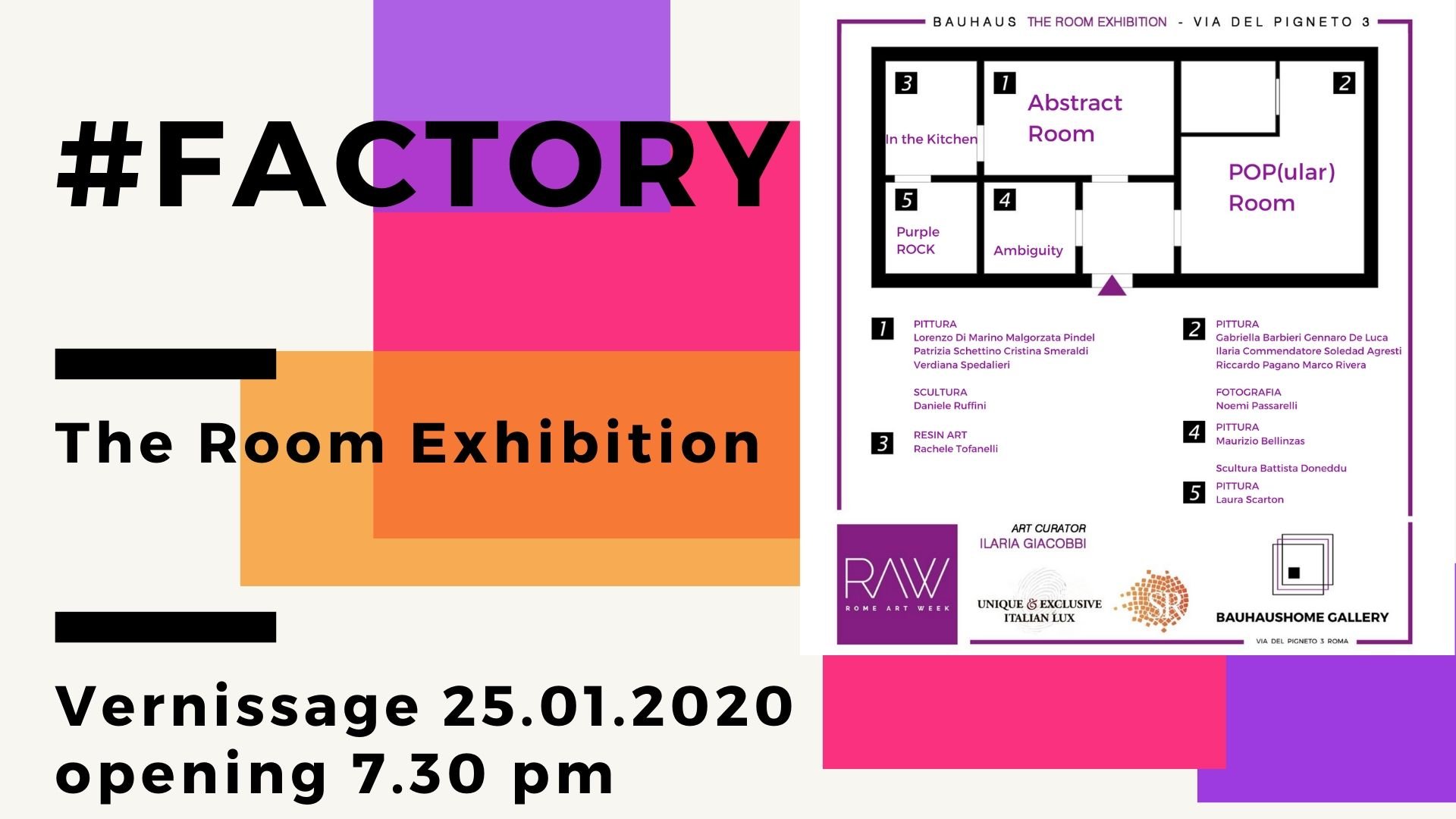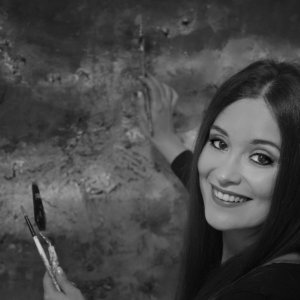It was 1962 and at 231 East 47th Street, in Manhattan the brilliant and multifaceted Warhol founded the Factory,the Factory, where he creates, experiments and dares: a workshop of theArts home to his diverse artistic activity in which he operates as in a large workshop. An apartment in a disused factory becomes so creative forge and place of sharing.
Today, more than yesterday, the artist is a mediapersonality, subject and no longer a spectator of the communication to which hedraws; it is no longer (only) a "pop eye" but he himself character, con different techniques and approaches contaminates the processes and characters typical of High art that are reworked with the figures, times and codes of popular and mass culture oftheirera but never forgetting the great Masters of Art to which it is always inspired.
#Factory,included in the cycle "The Room Exhibition",is a collective exhibition that through the different forms of artistic language deepens the term POP,understood as POPular culture,re-actualizing it: Bauhaus Gallery Home,is an informal exhibitionspace, a house-atelier where contemporary artists as in A Factory exhibits their creations, they create objects of furniture and design and intervene in the space leaving a tangible sign of their presence. Fundamental is the dialectical relationship with the viewer/user who now sees the work of art cleared from its natural exhibition context to be (re)placed within the home walls.
Land artistic creations are placed in each room, divided by style or current, with an arrangement that does not alter the domestic space but with the work of ART dialogues: an exhibition path in a house/museum where the compatriots of furniture and design are deduced fromthe worksthemselves. The lighting, the light, conceived as a fundamental element (for the set-up) reflects and breaks down creating brilliant effects in space.
#ARTISTS: Lorenzo Di Marino - Malgorzata Pindel - Patrizia Schettino - Cristina Smeraldi - Verdiana Spedalieri – Rachele Tofanelli - Gabriella Barbieri - Gennaro De Luca - Ilaria Commendatore - Riccardo Pagano - Marco Rivera – Maurizio Bellinzas – Battista Doneddu – Laura Scarton - Noemi Passarelli - Daniele Ruffini – Soledad Agresti
ArtCurator Ilaria Giacobbi
_____
POP(ular) ROOM
Famousicons, icons ofthe past, false authors :hovering between past and present that in the stylistic synthesis show their own essence POP, Ilaria Commendatore (pen to Bic) and Riccardo Pagano (painting and collage) present a selection of "faces-icons" that compare two different techniques of esucuation daughters of this era. The figurative works of Soledad Agresti, Gennaro De Luca and Marco Rivera,in thecontinuumnarrative of the exhibition,are used as anell i in conjunction with the false authors of Gabriella Barbieri.
The photographic section is reserved for the photographic reportage "Sardine" made by Noemi Passarelli during the event that took place in Rome in Piazza San Giovanni in Laterano: the artist ofthetwentyactive spectator, the investigating eye ofhis time, and photography takes on the role of document/visual. Contemporary for posterity.
-
ABSTRACT ROOM
In the abstract dimension, the concepts of environment, nature, seasons and climate change are summarized: the color of the wind in the triptych of Verdiana Spedalieri becomes mirror, on the opposite hand, to that of Cristina Smeraldi that brings us back to the peace of mind, heart and soul... that only by the sea can be found. The color, with its evocative power, becomes the absolute protagonist in the work of Malgorzata Pindel: stretched out on the canvas until itsaturates and permeates it, pasty and material through the chromatic variations creates forms in the abstract.
The whiteness of the canvas, conceived as a huge blank page by Patrizia Schettino and Lorenzo Di Marino, is enhancedbythedrama and symbolic value of black,imprinted through the gestural-creative act: elements taken from the natural environment (Patrizia Schettino, pine needles) and/or color ( Lorenzo Di Marino through brushstrokes full of energy and plastic power synthesizes animal forms).
In the dimension of black and white are the sculptures of Daniele Ruffini: the artist mentions the famous works of Kandinsky, Thus, he manifests his design intent based on the continuous search for a spatial and expressive organization that is realized by the use of geometricalized forms in the name of a rationalistic need; but also pays homage to Mondrian's "Compositions", (reproposing a three-dimensional and material version), to which he draws for the realization that leads to the final state obtained by the lattice aggregation of geometric blocks with iron black lines, in horizontal, vertical and oblique planes.
-
IN THE KITCHEN:
Rachele Tofanelli's mini-staff places art in everyday domestic and convivial "sharing" par excellence: the kitchen.
From theartist'spictorialworks, made through theego of the returnsna, are derived objects of furniture & design (author).
AMBIGUITY
The bi-personal installation of Maurizio Bellinzas and Battista Doneddu summarizes, through the comparison between painting and sculpture, the concept ofanmbguity to which they coincide the sexual one through the metaphor of the language of art. They create the misunderstanding and place the viewer a condition implying the possibility of a double interpretation.
Purple Rock
The work of Laura Scarton, is placed in the collective in a section dedicated to it and from which it takes the title: Purple Rock. Dto the mixture of blue and red,wisdom with loveand the Purple comes to life the color of spirituality that has always symbolically represented mystery, magic and metamorphosis. The artist gives completeness to the value of the work by adding the component of the mineral element that refers to the purifying and liberating force: the viewer thanks tothe energy of thepurple color comes into contact with his spiritual part and with our higher Self.
2(be)MODArt: artists, in full POP style, "exhibit" their works also on a piece of clothing, In line at the beginning"BE... ARTE, "theessence together with the appearance", present a collection that reproduces, in LIMITED ED., the works of art, reproduced on clothing that become "EXASPOSITION Spaces (IN)FORMALI" conveying a work of art.
2(be)MODArt is a way of being that is manifested through one's own style but makes us become an active part of a process of sharing art: (healthy) bearers of Art. On the move.
The Home Gallery as the place of choice of art also takes up the Wunderkammer principle, to allow the individual constant and daily enjoyment, but also personal and intimidating.
https://www.youtube.com/watch?v=hvMg_OQw1Dg
- VERNISSAGE 25.01.2020 OPENING: 7.30 PM
LUN ? COME 11.30 – 13.30 / 17.00 – 19.00
OPEN STUDIO WITH THE ARTISTS LUN | VEN 19.30 / 21.00
Bauhaus Home Gallery
Pigneto Street 3
Rome
Located in the famous and historic district of Pigneto, a short walk from the Termini Station, a triangle of streets with a retro charm between the Prenestina street and the Casilina street where shreds of imperial history coexist with a Romanesque ness in constant transformation."
The Pigneto is the winning combination of two opposing and strong personalities, the daytime one representative of the characteristic Romanesque soul, and the nocturnal one symbol of a recent and sought-after reality of the Roman movida.
The Pigneto is the district of 'Accattone' and Pier Paolo Pasolini, as well as the set of other great films such as "Rome open city" by Roberto Rossellini with Anna Magnani and Aldo Fabrizi.
Today the centerpiece of Roman Urban Art, a neighborhood that ooss energy 24 hours a day."
L’ Arte esce dalle Gallerie Istituzionali per essere vissuta nella quotidianità
Artists
Curators



